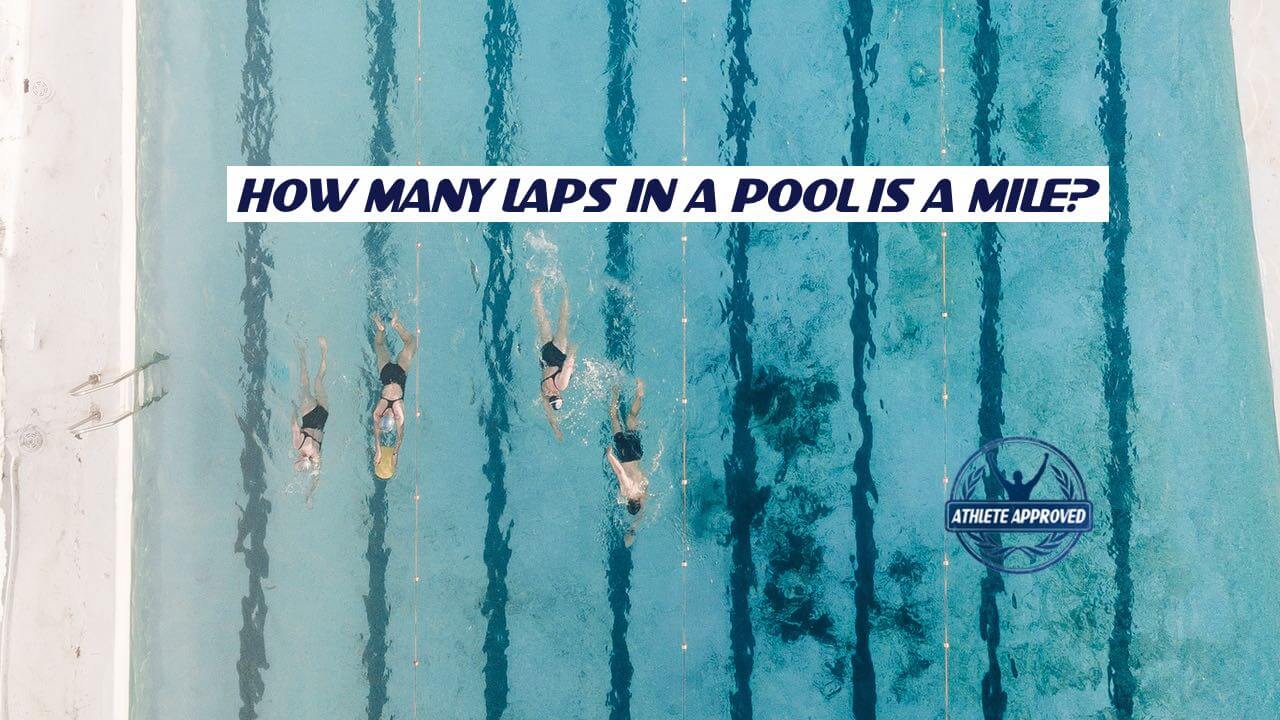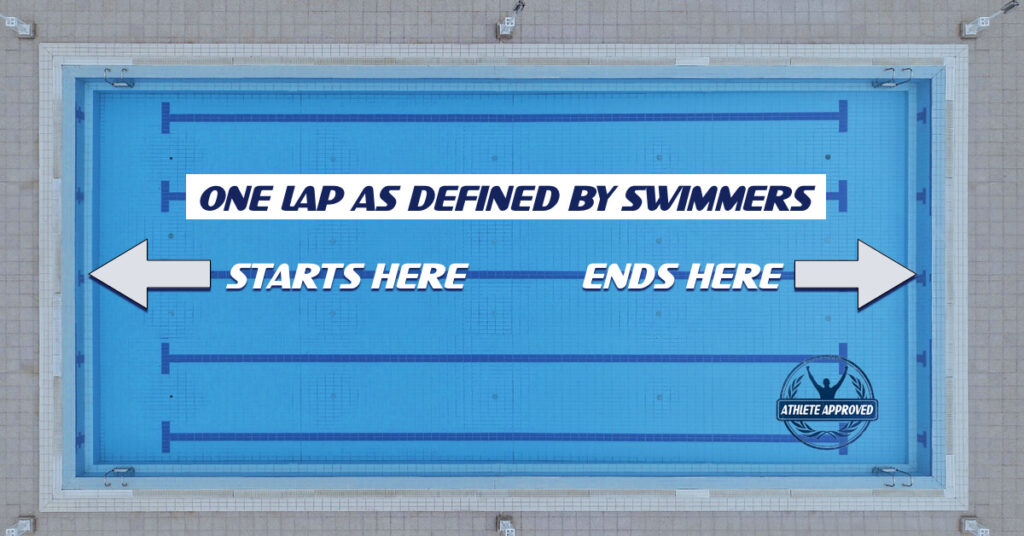
Athlete Approved is reader supported. If you make a purchase through our links, we earn an affiliate commission, at no extra cost to you. We highly recommend all products and only promote items that are Athlete Approved.
The most commonly asked question at the pool: How many laps are a mile? The answer to this question is so simple and very complicated, all at the same time.
Simply put, a mile in a pool exactly measured out equals:
- 70.4 laps in a 25 yard pool
- 64.4 laps in a 25 meter pool
- 32.2 laps in a 50 meter pool
Any competitive swimmer will raise their eyebrows at those numbers because in competitive swimming, a pool mile equals:
- 66 laps in a 25 yard pool
- 60 laps in a 25 meter pool
- 30 laps in a 50 meter pool
And to make matters even more complicated, we need to agree how to define one lap. We define it the same as one length. It is the distance from one wall to the next.
Standard pool lengths can be are measured based on yards and meters. Therefore, it can be confusing! In this article, we explain each type of pool and how many laps you have to complete in each to swim one mile.
- Short Course Yards Pool
- Short Course Meter Pool
- Long Course Meter Pool
- Bonus: 30 Meter Pool
- What Is A Lap?
- Open Water Swimming Mile
Short Course Yard Pool
The majority of pools in the United States are 25 yards long. These types of pools are called short course yards.
To complete a mile in short course yards, you will need to swim 70.4 laps if you go by exact distance or 66 laps if you go by the competitive swimming standard.
Notable competitions in short course yards:
- USA Swimming age-group Fall, Winter, and Spring Seasons
- High School
- NCAA (college)
The short course yards American Record in the 1650 at the time of article posting is 14:12.08 by Bobby Fink!
We do not call short course yard records World Records, since only the United States recognizes them. The American Record is the fastest American. The US Open Record is the fastest on American soil.
Breaking 16:30 is a great goal for fast swimmers because they average under one minute per 100.
A time under 20 minutes is great for a recreational lap swimmer. Under 30 minutes is a great goal for a intermediate/beginner swimmer.
Short Course Meter Pool
Outside of the United States, the most common pools are 25 meters long. These are called short course meters.
For a comparison to short course yards, 25 meters = 27.3 yards. So short course meters is about 2-3 extra strokes longer.
To complete a mile in short course meters, you will need to complete 64.4 laps if you go by exact distance or 60 laps if you go by the competitive swimming standard.
Notable competitions in short course meters:
- FINA World Championships in even years (ie 2022, 2024, 2026)
- International Swimming League
The World Record for 1500 short course meters (60 laps) is currently 14:06.88 by Florian Wellbrock.
Long Course Meter Pool
Lastly, there are Long Course Meter Pools that are 50 meters. They are also known as Olympic sized pools or long course meters.
To complete a mile in long course meters, you will need to swim 32.2 laps if you go by exact distance or 30 laps if you go by the competitive swimming standard.
Notable competitions in long course meters:
- The Olympic Games
- FINA World Championships in odd years (ie 2021, 2023, 2025)
- USA Swimming age-group Summer Season
The fastest 1500 meters (30 laps) time is held by Sun Yang in 14:31.02!
Bonus: 30 Meter Pool
You may even find a 30 meter pool, which isn’t as uncommon as you would think.
For this uniquely sized pool, you will need to swim 53.6 laps of the pool to reach a mile. There is no competitive swimming standard in this length because 30 meters is not a recognized distance.
One lap in 30 meters is about 33 yards. So for those of you who think in yards, you can create your swim workouts keeping in mind that 3 laps is about 100 yards.
What Is A Lap?
Before we talk about how many laps you need to swim in order to reach a mile, we need to define a lap.
Too often people get confused between a lap and a length.
Some swimmers believe that one lap of a swimming pool consists of swimming from one end of your pool to another.
Other swimmers believe that one lap of a swimming pool consists of swimming to one end of the pool and back to the other end, where you started.
While the debate goes on, we define one lap the same as one length. It is the distance from one wall to the next wall.
Competitive swimmers follow this definition. Some recreational lap swimmers define it the other way.
If are stuck in your ways and want to define a lap as down-and-back, then cut all of the lap numbers in this article in half!
Open Water Swimming Mile
You may not always be able to swim in a pool or you may choose to take your swimming to the open water.
It is difficult to track one mile in open water. First, we do not have the luxury of pre-measured walls. Secondly, the earth is not shaped like a perfect sphere. Thirdly, a nautical mile is recognized as slightly longer than one mile on land.
Generally a nautical mile is measured by “one minute of swimming the latitude” that equals 1.15 miles. That converts to 1,852 meters or 2025 yards.
This measurement is generally used by planes or boats for navigation purposes. However, this method is not always accurate, because the closer you swim to the poles of the Earth, the longer a nautical mile becomes.
As a result a nautical mile has been standardized to 1.15 miles.
Conclusion
In this article, we answer the age-old question: how many laps in a pool are a mile?
The answer can be tricky given the different types of pools and the differences between a true mile and competitive swimming mile.
Reference the below chart to see the true mile distance and competitive swimming mile distance.
| True Mile Distance | Competitive Swimming Mile | |
| 25 Yard Pool | 70.4 Laps | 66 Laps |
| 25 Meter Pool | 64.4 Laps | 60 Laps |
| 50 Meter Pool | 32.2 Laps | 30 Laps |
We hope you have found this article useful and have a better understanding on how many laps you need to complete to swim one mile in the pool!
*Equip yourself for success with our Athlete Approved Guide to Lap Swimming Equipment!*

No comment yet, add your voice below!